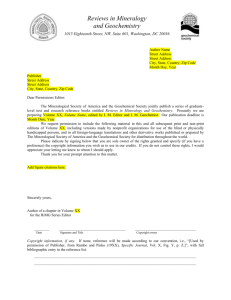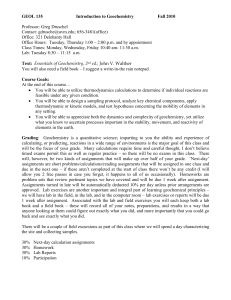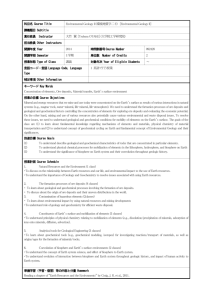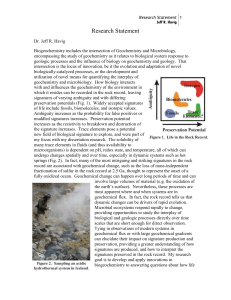Greg Druschel - CV 01-06
advertisement
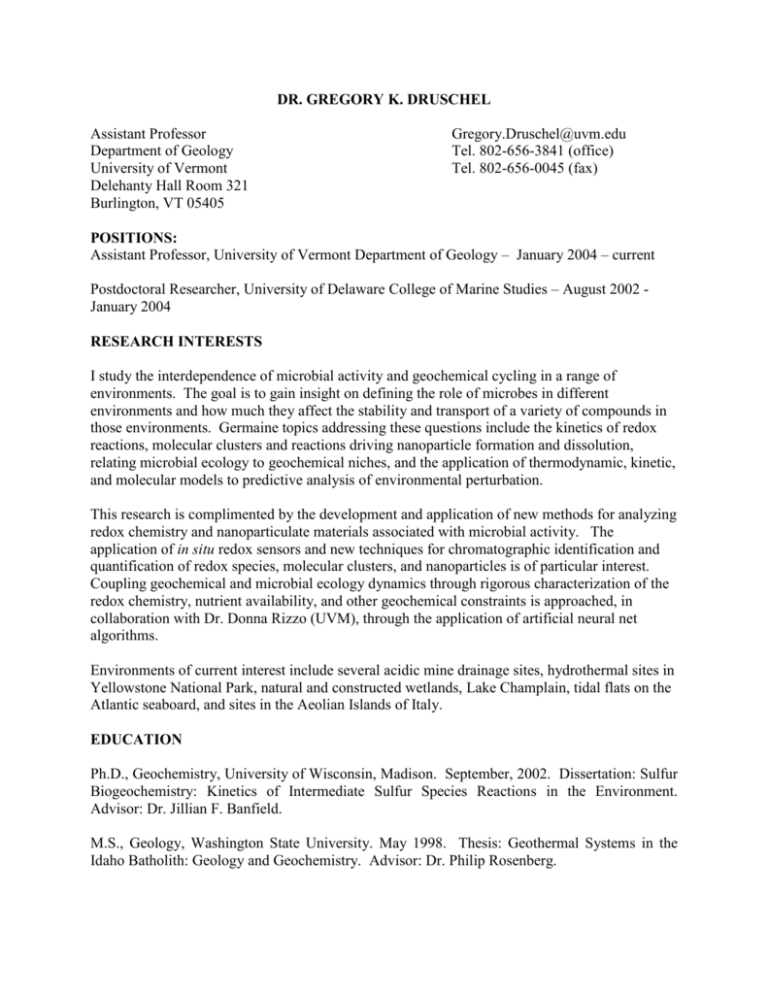
DR. GREGORY K. DRUSCHEL Assistant Professor Department of Geology University of Vermont Delehanty Hall Room 321 Burlington, VT 05405 Gregory.Druschel@uvm.edu Tel. 802-656-3841 (office) Tel. 802-656-0045 (fax) POSITIONS: Assistant Professor, University of Vermont Department of Geology – January 2004 – current Postdoctoral Researcher, University of Delaware College of Marine Studies – August 2002 January 2004 RESEARCH INTERESTS I study the interdependence of microbial activity and geochemical cycling in a range of environments. The goal is to gain insight on defining the role of microbes in different environments and how much they affect the stability and transport of a variety of compounds in those environments. Germaine topics addressing these questions include the kinetics of redox reactions, molecular clusters and reactions driving nanoparticle formation and dissolution, relating microbial ecology to geochemical niches, and the application of thermodynamic, kinetic, and molecular models to predictive analysis of environmental perturbation. This research is complimented by the development and application of new methods for analyzing redox chemistry and nanoparticulate materials associated with microbial activity. The application of in situ redox sensors and new techniques for chromatographic identification and quantification of redox species, molecular clusters, and nanoparticles is of particular interest. Coupling geochemical and microbial ecology dynamics through rigorous characterization of the redox chemistry, nutrient availability, and other geochemical constraints is approached, in collaboration with Dr. Donna Rizzo (UVM), through the application of artificial neural net algorithms. Environments of current interest include several acidic mine drainage sites, hydrothermal sites in Yellowstone National Park, natural and constructed wetlands, Lake Champlain, tidal flats on the Atlantic seaboard, and sites in the Aeolian Islands of Italy. EDUCATION Ph.D., Geochemistry, University of Wisconsin, Madison. September, 2002. Dissertation: Sulfur Biogeochemistry: Kinetics of Intermediate Sulfur Species Reactions in the Environment. Advisor: Dr. Jillian F. Banfield. M.S., Geology, Washington State University. May 1998. Thesis: Geothermal Systems in the Idaho Batholith: Geology and Geochemistry. Advisor: Dr. Philip Rosenberg. B.S., Geology, Earth Science, and Chemistry (minor). Muskingum College, New Concord, OH. May 1995. Honors Thesis: The variation of iron and arsenic concentrations in the surface water of an acid mine drainage area at the Wills Creek Reservoir. PROFESSIONAL ACTIVITIES Chaired and organized a symposium at the 2005 Goldschmidt Meeting in Moscow, Idaho on “Geochemical controls on microbial processes”. The Goldschmidt meeting is the annual international meeting of the Geochemical Society and European Union of Geochemistry. Chaired and organized 2 sessions at the March 2003 ACS national meeting in New Orleans on metal sulfide chemistry. Reviewer for the National Science Foundation, Department of Energy, Geochimica et Cosmochimica Acta, Environmental Science and Technology, Aquatic Geochemistry, Journal of Geophysical Research, and Geochemical Transactions. Panel member, Environmental Protection Agency Graduate Fellowships panel, February 14-16, 2006. Guest Editor, Geobiology Special Edition “Geochemical controls on microbial processes”, in press Associate Editor, Geochemical Transactions, starting January 2006 Associate Editor, Aquatic Geochemistry, starting November, 2005 Member of the ACS Division of Geochemistry, Geochemical Society, Mineralogical Society, American Geophysical Union, and Geological Society of America. Member of the Lake Champlain Basin Program’s advisory board on Toxics in Lake Champlain. Member of the Saint Albans Bay remediation assessment advisory board PUBLICATIONS Bond P.L., Druschel G.K., and Banfield J.F., 2000: Comparison of acid mine drainage microbial communities in physically and geochemically distinct ecosystems. Applied And Environmental Microbiology, Vol. 66, Iss. 11, pp 4962-4971. Druschel., G.K., Hartmann, A., Lomonaco, R. and Oldrid, K., 2005: Determination of sediment phosphorus concentrations in St. Albans Bay, Lake Champlain: Assessment of internal loading and seasonal variations of phosphorus sediment-water column cycling. Report to the Vermont Agency of natural resources, 71 p., http://www.vermont.gov/cleanandclear/stalbansbay.htm Druschel , G.K. and Borda, M., in press: Comment on “Pyrite dissolution in acidic media” by M. Descostes, P. Vitorge, and C. Beaucaire. Geochemica et Cosmochimica Acta. Druschel G.K., Rosenberg P.E., 2001: Non-magmatic fracture-controlled hydrothermal systems in the Idaho Batholith: South Fork Payette geothermal system. Chemical Geology, Vol. 173, Iss. 4, pp 271-291. Druschel, G.K., Schoonen, M.A.A., Nordstrom, D.K., Ball, J.W., Xu, Y., And Cohn, C., 2003: Sulfur geochemistry of hydrothermal waters in Yellowstone National Park, Wyoming, USA. III: An anion-exchange resin technique for sampling and preservation of sulfoxyanions in natural waters. Geochemical Transactions Vol. 4, No. 3, p. 12-19. Druschel, G.K., Labrenz, M., Thomsen-Ebert, T., Fowle, D.A. and Banfield, J.F., 2002: Biogenic Precipitation of Monomineralic Nanocrystalline Sulfides: Implications of Observed and Modeled Processes to Ore Deposition. Economic Geology Vol. 97, No. 6, p.1319-1329. Druschel, G.K., Hamers, R.J., and Banfield, J.F., 2003: Kinetics and mechanism of homogeneous polythionate oxidation at low pH with oxygen and ferric iron. Geochimica et Cosmochimica Acta Vol. 67, No. 23, p. 4457-4469. Druschel, G.K., Hamers, R.J., Luther, G.W., and Banfield, J.F., 2003: Kinetics and mechanism of trithionate and tetrathionate oxidation at low pH by hydroxyl radicals. Aquatic Geochemistry. V. 9 No. 2, p. 145-164. Druschel, G.K., Baker, B.J., Gihring, T.H., and Banfield, J.F., 2004: Acid mine drainage biogeochemistry at Iron Mountain, California. Geochemical Transactions Vol. 5, No. 2, pp. 13-32. Druschel, G.K., Sutka, R, Emerson, D., Luther, G.W., Kraiya, C., and Glazer, B., 2004: Voltammetric investigation of Fe-Mn-S species in a microbially active wetland. In: Proceedings of the Eleventh International Symposium on Water-Rock Interaction WRI11. Wanty, R.B. and Seal, R.R (eds.). p. 1191-1194. Druschel, G.K. and Borda, M., submitted: Comment on “Pyrite dissolution in acidic media” by M. Descostes, P. Vitorge, and C. Beaucaire. Geochimica et Cosmochimica Acta. Edwards K.J., Bond P.L., Druschel G.K., McGuire M.M., Hamers R.J., Banfield J.F., 2000: Geochemical and biological aspects of sulfide mineral dissolution: lessons from Iron Mountain, California. Chemical Geology, Vol. 169, Iss. 3-4, pp 383-397. Gihring, T.M., Druschel, G.K., McCleskey, R.B., Hamers, R.J., and Banfield, J.F., 2001: Rapid arsenite oxidation by Thermus aquaticus and Thermus thermophilus: Field and laboratory investigations. Environmental Science and Technology, Vol. 35, No. 19, pp. 3857-3862. Hu, B, Higgins, S.R., Druschel, G.K., Banfield, J.F., and Hamers, R.J., in review: Surface Chemical and microscopic investigation of galena dissolution in perchloric acid. Geochimica et Cosmochimica Acta. Labrenz M., Druschel G.K., Thomsen-Ebert T., Gilbert B., Welch S.A., Kemner K.M., Logan G.A., Summons R.E., De Stasio G., Bond P.L., Lai B., Kelly S.D., Banfield J.F., 2001: Formation of sphalerite (ZnS) deposits in natural biofilms of sulfate-reducing bacteria. Science, Vol. 290, Iss. 5497, pp 1744-1747. Luther, G.W., III, Glazer, B., Ma, S., Trouwborst, R., Schultz, B.R., Druschel G.K., Kraiya, C., 2003: Iron and sulfur chemistry in a stratified lake: Evidence for iron-rich sulfide complexes. Aquatic Geochemistry V. 9, No. 2, p. 87-110. George W. Luther, III, Brian Glazer, Shufen Ma, Robert E. Trouwborst, Tommy S. Moore, Chareonkwan Kraiya, Tim J.Waite, Gregory Druschel, Bjørn Sundby, Martial Taillefert, Donald B. Nuzzio, Timothy M. Shank, in review:Use of voltammetric solid-state (micro)electrodes for studying biogeochemical processes: laboratory measurements to real time measurements with an in situ electrochemical analyzer (ISEA). Marine Chemistry, special issue dedicated to Joris Gieskes Porada, H., and Druschel, G.K., in prep: Microbial mats participating in the deposition of the siliciclastic ‘ore formation’ in the Copperbelt of Zambia. Economic Geology. Roesler, A.J., Gammons, C.H., Druschel, G.K., Oduro, H., and Poulson, S.R., in review: Geochemistry of flooded underground mine workings influenced by bacterial sulfate reduction. Geochimica et Cosmochimica Acta. ABSTRACTS AND PRESENTATIONS Druschel, G.K., 2006: Linking chemistry and microbes: using in situ microelectrodes in the field and in the lab. Presented to the Plant and Soil Sciences Department, University of Vermont, January 27, 2006 Druschel, G.K., 2006: Minerals and Microbes: Field studies in California, Vermont, Montana, and Italy. Presented to the Burlington Gem and Mineral Society, January 26, 2006. Druschel, G.K., 2006: In situ microelectrodes in the field and in the lab: Linking geochemical cycling with microbial activity. Presented to the Department of Geology, University of South Florida, January 20, 2006. Druschel, G.K., Lorenson, G., Eastmann, D.A., Macalady, J., 2005: Redox speciation and biogeochemical gradients: Assessing spatial niches and monitoring dynamics in natural systems with voltammetric microelectrodes. Presented at the 2005 National Meeting of the American Geophysical Union, San Francisco, CA, December 8, 2005 Mouser, P.J., Rizzo, D.M., Druschel, G.K., O’Grady, P., and Stevens, L., 2005: Innovative Methods for Integrating Knowledge for Long-Term Monitoring of Contaminated Groundwater Sites: Understanding Microorganism Communities and their Associated Hydrochemical Environment. Presented at the 2005 National Meeting of the American Geophysical Union, San Francisco, CA, December 8, 2005 Druschel, G.K., 2005: Geochemical niches for microbes and details of sulfur cycling seen through the use of voltammetric microelectrodes. Presented to the Geology Department, Massachussets Institute of Technology, October 28, 2005. Druschel, G.K., 2005: Tools and Methods for thinking about the role microbes play in environmental processes. Presented to the Peace Partners: Arab-Israel-Vermont Global Water Resources Symposium, October 6, 2005. Druschel, G.K., 2005: Microbial Geochemistry: Field excursions and lab experiments to look at the links between microbes and geochemical cycling. Presented to the Geology Department at Middlebury College, September 27, 2005. Druschel, G.K., 2005: In situ microelectrodes in the field and in the lab: Linking geochemical cycling with microbial activity. Presented to the Geology Department of McGill University, September 23, 2005. Druschel, G.K., 2005: Methods to investigate sediment and water column redox chemistry changes associated with nutrient availability. Presented at the PRIME Meeting, Tyler Place, VT, September 12 Druschel, G.K., 2005: In situ microelectrodes in the field and in the lab: Linking geochemical cycling with microbial activity. Presented to the School of Natural Resources, September 6, 2005. Druschel, G.K., Lorenson, G.L., Mouser, P., Rogers, D., Oduro, H., Hartmann, A., and Rizzo, D.M., 2005: Using voltammetry in the environment to constrain microbial activity. Presented at the annual EPSCoR meeting, Burlington, VT, August 15, 2005. Druschel, G.K., 2005: Determination of sediment phosphorus concentrations in St. Albans Bay, Lake Champlain: Assessment of internal loading and seasonal variations of phosphorus sediment-water column cycling. Presented to the St. Albans Town Selectboard meeting, July 11, 2005. Lorenson, G., Rogers, D., Price, R., Edwards, K., and Druschel, G.K., 2005: Application of in situ Au-amalgam microelectrodes in Yellowstone National Park to guide microbial sampling. Presented at the 2005 Goldschmidt Conference, Moscow, ID, May 2005. Druschel, G.K., Lorenson, G., Rizzo, D., Rogers, D, and Edwards, K., 2005: Field, lab, and computational tools and techniques for linking geochemical and microbial processes in a range of environments. Presented at the 2005 Goldschmidt Conference, Moscow, ID, May 2005. Druschel, G.K., 2005: In situ microelectrodes in the field and in the lab: Linking geochemical cycling with microbial activity. Presented to the Geology Department at Washington University in St. Loius, MO March 23, 2005. I Druschel, G.K., 2005: In situ microelectrodes in the field and in the lab: Linking geochemical cycling with microbial activity. Presented to the Geology Department at Penn State University April 4, 2005. I Druschel, G.K., 2004: Current state of research on P loading in St. Albans Bay, VT. Presented to the St. Albans Bay Watershed Association, September 2004. I Druschel, G.K, Emerson, D., Luther, G.W. ., Sutka, R, Kraiya, C., and Glazer, B., 2004: Environmental limits of the circumneutral iron-oxidizing bacterial isolate ES-1: Field, culture, and kinetic results from voltammetric analyses. Presented at the V.M. Goldscmidt Conference, Copenhagen, Denmark June 2004. RP Druschel, G.K., 2004: Models, tools, and observations regarding microbial activity: Metal sulfide formation and oxidation examples. Presented to the faculty of Geology at the University of Göttingen, Germany June 2004. I RESEARCH GRANTS VT DEC, A proposal for determination of sediment phosphorus concentrations in St. Albans Bay, Lake Champlain: Assessment of internal loading and seasonal variations of phosphorus sediment-water column cycling. Druschel (PI) $25,000. Completed ACS-PRF Type SE grant, support for ACS symposia on metal sulfide chemistry presented at the 2003 ACS National Meeting, New Orleans, USA. Druschel and Borda, $3,600. VT EPSCoR Equipment Grant, Development of a biogeochemical kinetics reactor vessel as a tool for geology, chemistry, microbiology, environmental science, mathematics, and engineering to deconstruct complex environmental systems. $9,842. UVM Dean’s Fund: Development of new in situ voltammetric probes for long term deployment in hydrothermal areas. Druschel, $2,000. VT EPSCoR Graduate Research Assistantship, Investigation of elemental sulfur oxidation as a biocomplexity model: Coupling geochemical and microbial ecology data using Artificial Neural Networks. Druschel. 1 year graduate assistantship for current masters student. National Science Foundation, Petrology and Geochemistry Accomplishment based renewal (NSF-EAR) 0106614: Fe and S isotope fractionations in iron sulfides. Johnson (PI), Beard (Co-PI), Schoonen (Co-PI), and Druschel (Co-PI). $493,046. Denied American Chemical Society, Petroleum Research Fund: Formation and oxidation of FeS(aq) molecular clusters – Decoupling iron sulfide mineral surface dissolution and oxidation reactions. Druschel (PI), $35,000. Granted HELiX Award to A. Hartmann, G. Druschel, advisor: Evaluating the effect of sedimentary Fe/S redox changes coupled with P and N release in St. Albans Bay, Lake Champlain and its effect on secondary algal blooms over the course of the summer. Granted U.S. Department of Defense: CUSON-06-04: Subsurface Variability Mapping: A New Tool for optimizing Phytoremediation of RDX-Contaminated Soils. PI: Gil Bussod (New England Research, Inc.), subcontractors (Co-PI’s): Druschel, Reynolds (Cold regions research, NH). $1,872,000. Denied. National Science Foundation, Microbial Observatory Program (NSF-BIO MO-MIP), 2004: Collaborative Research: Microscale Geochemical Gradients as Drivers of Microbial Diversity in Shallow Marine Hydrothermal Systems. Jocelyne DiRuggiero (PI); Co-PI’s: Jan Amend, Joel Heidelberg, Greg Druschel. $1,999,988 total, $493,597 (UVM portion). Denied Department of Energy Natural and Attenuated Bioremediation (DOE NABIR): Uranium stability and mobility associated with iron oxidizing microorganisms: A physiological and electrochemical study. Lewis (PI) and Druschel (Co-PI) $774,000. Denied. National Science Foundation, Biocomplexity in the Environemnt, Coupled Biogeochemical Cycles Program (NSF-BE-CBC), 2004: Investigation of Elemental Sulfur Transformations in the Environment, a Multi-Disciplinary Study of Interdependences in Geochemical Cycles and Microbial Ecology. PI: Druschel, Co-PI’s: Edwards, Lewis. Denied National Science Foundation, Research Experience for Undergraduates Program (NSF-REU) supplement: Microbial community controls on sulfide oxidation rates and cave formation in a subsurface biogeochemical system. Macalady (PI), Druschel (Collaborator). 22,788. funded National Science Foundation, Microbial Observatory Program (NSF-MCB), 2005: Collaborative Research: MO: Microbial Observatory at Green Lake (MOGL). Kump (PI), Co-PI’s: House, Druschel, Arthur, Bryant, Carrick, Freeman, Holen, Macalady, Regan. $1,534,336 total, $116, 808 (UVM portion). In review National Science Foundation, Microbial Observatory Program (NSF-MCB), 2005: Collaborative Research: Geochemical Gradients as Drivers of Microbial Diversity in Shallow Hydrothermal Systems. DiRuggierro (PI), Co-PI’s: Druschel, Amend, Heidelberg. $559,437 (UVM Portion). In review. National Science Foundation, Earth Sciences, Geobiology and Low Temperature Geochemistry Program (NSF-EAR GEG), 2005: Evaluating the scale-dependence of microbial complexity through investigating geochemical niches and microbial diversity. PI: Druschel, Co-PI’s: Rizzo. $316,964. In review National Science Foundation, Earth Sciences, 2005: Piloting an Interdisciplinary Watershed Field Camp. PI: Bierman, Co-PI’s: Druschel, Wemple, Rizzo, Watzin. $151,522. In review Environmental Protection Agency, Science to Achieve Results (EPA-STAR) 2005: Nonlinear responses to multiple stressors in lake and watershed ecosystems: biogeochemical controls, grazing, and cyanobacteria dominance. PI: Watzin, Co-PI’s: Druschel, Rizzo, Wilhelm. $790,672. In Review. Environmental Protection Agency, Science to Achieve Results (EPA-STAR) 2006: Links between sediment released nutrient dynamics and the formation, maintenance, and decline of toxic cyanobacteria blooms. PI: Watzin, Co-PI’s: Druschel, Rizzo, Wilhelm. $443,718. In Review.
